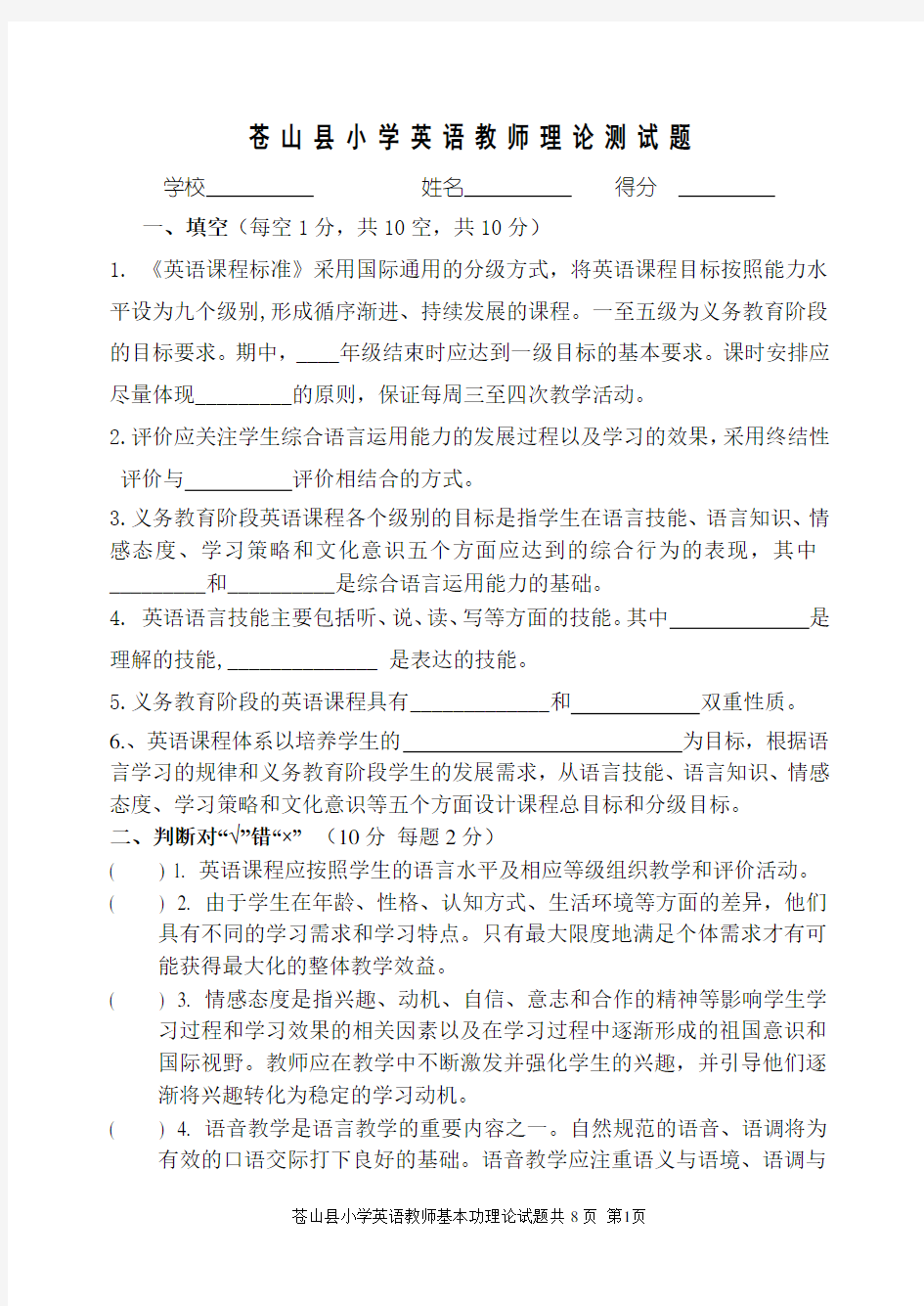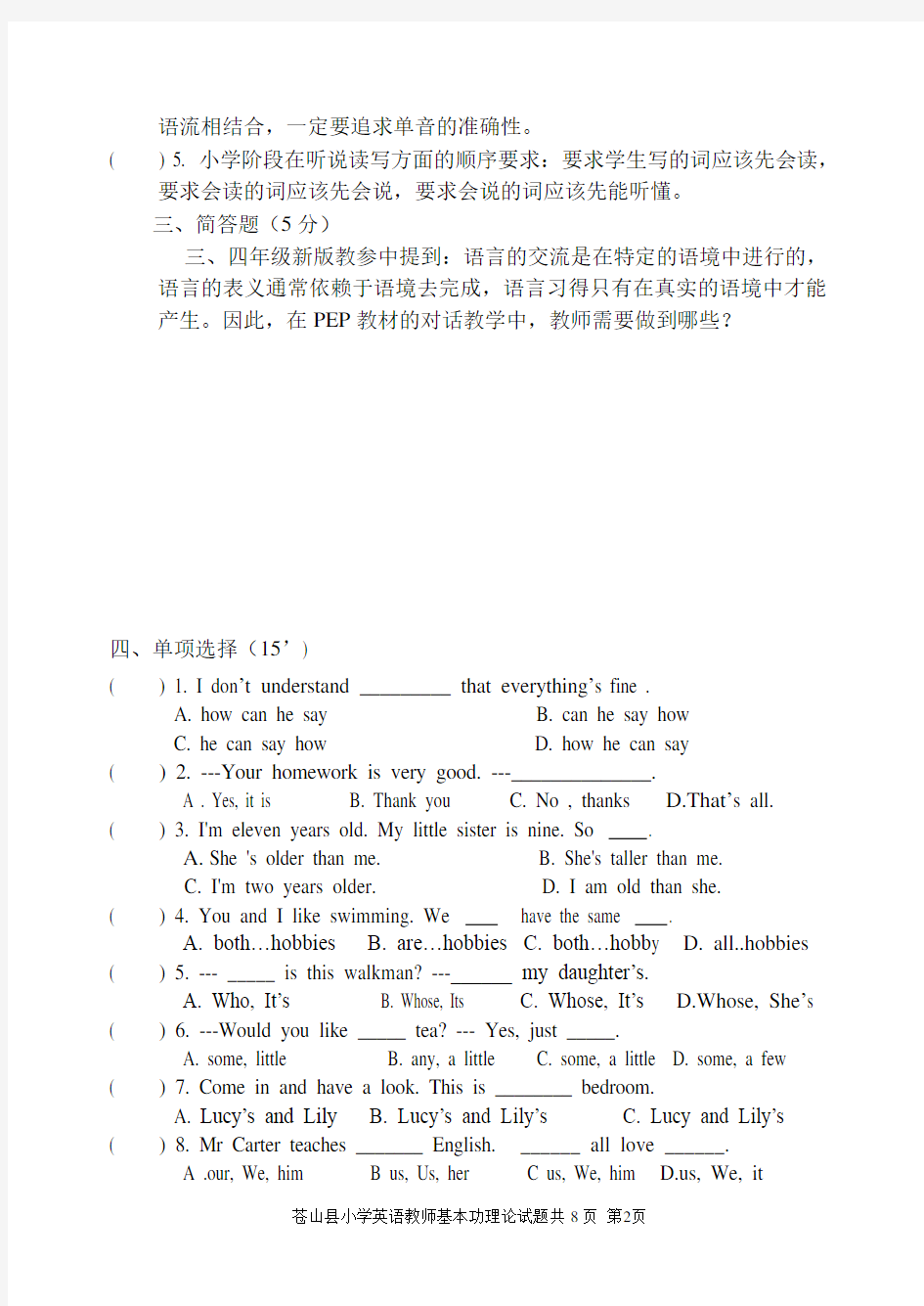

苍山县小学英语教师理论测试题
学校姓名得分
一、填空(每空1分,共10空,共10分)
1. 《英语课程标准》采用国际通用的分级方式,将英语课程目标按照能力水平设为九个级别,形成循序渐进、持续发展的课程。一至五级为义务教育阶段的目标要求。期中,____年级结束时应达到一级目标的基本要求。课时安排应尽量体现_________的原则,保证每周三至四次教学活动。
2.评价应关注学生综合语言运用能力的发展过程以及学习的效果,采用终结性评价与评价相结合的方式。
3.义务教育阶段英语课程各个级别的目标是指学生在语言技能、语言知识、情感态度、学习策略和文化意识五个方面应达到的综合行为的表现,其中_________和__________是综合语言运用能力的基础。
4. 英语语言技能主要包括听、说、读、写等方面的技能。其中是理解的技能,______________ 是表达的技能。
5.义务教育阶段的英语课程具有_____________和双重性质。
6.、英语课程体系以培养学生的为目标,根据语言学习的规律和义务教育阶段学生的发展需求,从语言技能、语言知识、情感态度、学习策略和文化意识等五个方面设计课程总目标和分级目标。
二、判断对“√”错“×” (10分每题2分)
( ) 1. 英语课程应按照学生的语言水平及相应等级组织教学和评价活动。( ) 2. 由于学生在年龄、性格、认知方式、生活环境等方面的差异,他们具有不同的学习需求和学习特点。只有最大限度地满足个体需求才有可能获得最大化的整体教学效益。
( ) 3. 情感态度是指兴趣、动机、自信、意志和合作的精神等影响学生学习过程和学习效果的相关因素以及在学习过程中逐渐形成的祖国意识和国际视野。教师应在教学中不断激发并强化学生的兴趣,并引导他们逐渐将兴趣转化为稳定的学习动机。
( ) 4. 语音教学是语言教学的重要内容之一。自然规范的语音、语调将为有效的口语交际打下良好的基础。语音教学应注重语义与语境、语调与
语流相结合,一定要追求单音的准确性。
( ) 5. 小学阶段在听说读写方面的顺序要求:要求学生写的词应该先会读,要求会读的词应该先会说,要求会说的词应该先能听懂。
三、简答题(5分)
三、四年级新版教参中提到:语言的交流是在特定的语境中进行的,
语言的表义通常依赖于语境去完成,语言习得只有在真实的语境中才能产生。因此,在PEP教材的对话教学中,教师需要做到哪些?
四、单项选择(15’)
( ) 1. I don’t understand _________ that everything’s fine .
A. how can he say
B. can he say how
C. he can say how
D. how he can say
( ) 2. ---Your homework is very good. ---______________.
A . Yes, it is B. Thank you C. No , thanks D.That’s all. ( ) 3. I'm eleven years old. My little sister is nine. So .
A.She 's older than me.
B. She's taller than me.
C. I'm two years older.
D. I am old than she.
( ) 4. You and I like swimming. We have the same .
A. both…hobbies
B. are…hobbies
C. both…hobb y
D. all..hobbies ( ) 5. --- _____ is this walkman? ---______ my daughter’s.
A. Who, It’s
B. Whose, Its
C. Whose, It’s
D.Whose, She’s ( ) 6. ---Would you like _____ tea? --- Yes, just _____.
A. some, little
B. any, a little
C. some, a little
D. some, a few ( ) 7. Come in and have a look. This is ________ bedroom.
A. Lucy’s and Lily
B. Lucy’s and Lily’s
C. Lucy and Lily’s ( ) 8. Mr Carter teaches _______ English. ______ all love ______.
A .our, We, him
B us, Us, her
C us, We, him https://www.doczj.com/doc/071659758.html,, We, it
( ) 9. Haven’t seen you for age, Mike,______?
----Pretty good! Everything goes well.
A.what are you doing
B.how are you
C. how’s it going
D. what’s wrong
( ) 10. Sometimes I ________ TV in the evening.
But this evening I’m ________.
A. watching, sleeping
B. watch, sleeping
C. watch, sleep
D. am watching, sleeping
( ) 11. There is __________ “h” and ________“f” in the word “half”.
A. an, the
B. a, an
C. a, a
D. an, an
( ) 12. He is playing________ piano and she is playing________ football.
A. /; /
B. the; /
C. /; the
D. a; the
( ) 13. Work hard ,________ you’ll succeed.
A. and
B. but
C. so
D.because
( ) 14. ---Hello! Is that Jenny speaking?
---Sorry, I’m afraid you have gotten wrong______.
A. number
B. name
C. address
D. message ( )15. weather we have today!
A. What nice
B. What a sunny
C. How beautiful
D. How a fine
五、阅读下面的短文,并根据短文内容答题。(40分)
A
If you spend some time in an English-speaking country you might hear the term “etiquette”. It means normal and polite social behavior. This may seem like a difficult word at first,but it can be very useful to understand.
Etiquette is not the same in every culture or in every situation. For example,standing very close to the person you are talking with is quite common in some Asian countries. However, if you do this in Europe, some people might feel uncomfortable. Even in China, we all know that etiquette is not the same in all situations. Perhaps we think that talking loudly in our own homes is fine,but there are other places where talking loudly is not allowed. For example, most people would agree that talking loudly in a library、a museum or a movie theater is impolite. Even if you are with your friends,it is better to keep your voice down in public places.
If we see someone breaking the rules of etiquette,we may politely give them some suggestions. One of the most polite ways is to ask someone,Would you mind doing this or Would you mind not doing that. People don’t usually like to be criticized,so we have to be careful how we do this.
Although rules of etiquette can often be different,some rules are the same almost everywhere in the world! For example,dropping litter is almost never allowed. If you see someone you know doing this,you can ask him,Would you mind picking it up?
1.What does the word “etiquette” mean? (根据短文内容回答问题)
2. Find out the key sentence of Paragraph 2. (找出第二段的中心句)
3.If your friend talks loudly in the library,what would you say to him/her? (根据你对短文的理解,写出一个委婉的建议)
4. 请将最后一段中的划线句子译成汉语。
5.请给短文拟个标题。
(B)
Scientists are trying to make the deserts (沙漠) into good land again, They want to bring water to the deserts, so people can live and grow food. They are learning a lot about the deserts. But more and more of the earth is becoming desert all the time. Scientists may not be able to change the desert in time.
Why is more and more land becoming desert? Scientists think that people make deserts. People are doing bad things to the earth. Some places on the earth don't get very much rain. But they still don't become deserts. This is because some green plants are growing there. Small green plants and grass are very important to dry places. Plants don't let the hot sun make the earth even drier. Plants don't let the wind blow the dirt away. When a little bit of rain falls, the plants hold the water. Without plants, the land can become a desert much more easily.
6. Deserts .
A. get very little rain
B. never have any plants or animals in them
C. can all be turned into good land before long
D. both A and C
7. Small green plants are very important to dry places because .
A. they don't let the sun make the earth even drier
B. they don't let the wind blow the earth away
C. they hold the water
D. all of the above
8. Land is becoming desert little by little because
A. plants can't grow there
B. there is not enough rain
C. people haven't done what scientists wish them to do
D. scientists know little about the deserts
9. Which is the main idea of the first paragraph?
A. Scientists know how to change desert into good land.
B. Land is becoming desert faster than scientists can change it back into good land,
C. If scientists can bring water to desert, people can live and grow there.
D. More and more places are becoming deserts all the time.
10. After reading this, we learn that, .
A. plants can keep dry land from becoming desert
B. it is good to get rid of the grass in the desert
C. all places without much rain will become deserts
D. it is better to grow crops on dry land than to grow grass
C
One morning, a blind boy sat beside a building with a hat by his feet. He held a sign which said, “I am blind. Please help me.”
There were only a few coins in the hat. A man was walking by. He took out a few coins from his pocket and dropped them into the hat. He then took the sign, turned it around, and wrote some words on it. He put the sign back so that everyone who walked by could see the new words.
Soon the hat began to fill up. A lot more people were giving money to the blind boy. That afternoon the man who had changed the sign came to see how things were. The boy recognized his footsteps and asked, “Are you the one who changed my sign in the morning? What did you write?”
The man said, “I only wrote the truth. I said what you said, but in a different way.”
What he had written was, “Today is a beautiful day, but I can’t see it.”
Do you think the first sign and the second sign were saying the same thing?
Of course both signs told people the boy was blind. But the first sign simply told people to help by putting some money in the hat. The second sign told people that they were able to enjoy the beautiful day, but the boy could not enjoy it because he was blind.
The first sign simply said the boy was blind, while the second sign told people they were so lucky that they were not blind.
There are at least two lessons we can learn from this simple story.
The first is: Treasure (珍惜) what you have. Someone else has less. Try your best to help those who need your help.
The second is: Be creative. Think differently. There is always a better way. 11. From the article we know that________.
A. the boy always has a hat on his head.
B. the man is one of his neighbors.
C. the boy is blind and needs help.
D. the boy works for the man.
12.On the sign what the man wrote was:
A. Treasure what we have already had.
B. Today is a beautiful day, but I can’t see it.
C. We are so lucky that we are not blind.
D. Try your best to help those who need your help.
13. According to the article, which of the following is TRUE?
A. The hat began to fill up after the man wrote some words on the sign.
B. The man took away all the few coins from the hat.
C. The boy wanted to get enough money to go to school.
D. Nobody wanted to give any coins to the blind boy.
14. The word “recognized” here in Chinese means _______.
A. 承认
B. 接受
C. 表扬
D.认出
15. _______ is the best title (题目) for this story.
A. Be careful not to be blind.
B. Be creative. There is always a better way!
C. Be kind to the blind!
D. Don’t always get, but offer!
D
A) 用括号内所给动词的适当形式填空,必要时可加助动词或情态动词。
A few weeks ago, a group of us decided to go abroad together for a holiday. When we____ 16(wait) in the queue at passport (护照) control I suddenly realized that I _____17 (leave) my passport at home. I rang my parents, but they were working in the garden. Luckily, my mother finally heard the phone. My passport 18_____(find) in my trousers pocket. My mother said, “If you take a taxi this minute, you 19_____ (be) able to get on the plane in time.” I 20_____ (run) all the way to the plane and when at last I got on it the other passengers started clapping (鼓掌).
答案: 16. ______________ 17. ____________ 18. ______________
19. ______________ 20. _____________
六、请对下面案例进行分析(5分)
教学目标:
1. 能够借助学校平面示意图,运用有关学校场所的英语单词,简单介绍学校场所,如教室、图书馆、办公室;
2. 能说出两幅学校平面示意图的区别。
教学内容:
1. 学习有关学校场所名称的单词:playground, classroom, office, art room, music room, computer room, library, toilet;
2. 学习描述学校的表达法,如There is an art room in our school。It is here。
教学活动:根据学校场所的实际位置把单词贴在平面示意图上并做简单的
描述。
课前准备:
1. 教师根据本学校的场所位置画一幅平面图(示意图),但不标出场所的名称。把平面图复印若干份(做活动时每小组一份)。
2. 把单词school, playground, classroom, office, art room, music room, computer room, library, toilet做成约2cm×3cm的小卡片(若干套)。做活动时每小组一套。
教学过程:
1.借助图片向学生呈现下列单词:school, playground, classroom, office, art room, music room, computer room, library, toilet。要求学生做到:(1) 看见图片能说出单词;(2) 给出单词能读出并能对应上图片。只要求学生能认读,不要求拼写。
2.教师先做示范,然后启发学生运用本课句型说说自己学校有哪些场所。
3.将学生按每组4~5人进行分组,小组成员必须围成一圈。每组发一张学校平面图和一套单词小卡片。要求学生在小组内根据学校场所的实际位置把单词贴在平面图上。
4.小组内学生轮流根据贴好的平面图向其他学生介绍学校某一场所,如:This is the playground. The music room is here.。鼓励学生使用以前所学词汇和句型进行创造性表达,如It is small, but I like it。
5.让学生分组设计一个理想学校的平面图,把单词卡片贴到平面图上,并用英语向全班作介绍。根据设计的合理性和语言表述的准确性评出优胜组。教师在学生需要时,给出单词或短语帮助学生表达。
【案例分析】:
七、教学设计(15分)
本节课是四上二单元My schoolbag
1.Part B部分请写出本课的教学目
标、重难点。
3.请写出对话课的基本教学步骤。
2.设计恰当的场景,对新知呈现环
节进行教学设计。